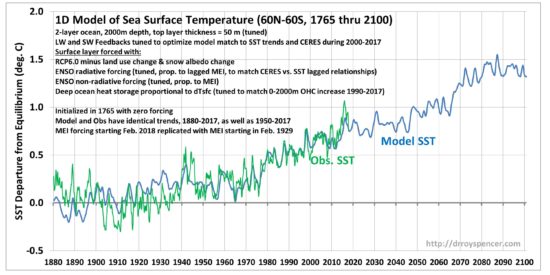My previous post dealt with a 1D model of ocean temperature changes to 2,000m depth, optimized to match various observed quantities: deep-ocean heat storage, surface temperature warming, the observed lagged-variations between CERES satellite radiative flux and surface temperature, and warming/cooling associated with El Nino/La Nina.
While that model was meant to match global average (land+ocean) conditions, I more recently did one for oceans-only (60N-60S). I changed a few things, so the models are not directy comparable. For example, I used all of the RCP6.0 radiative forcings, but with the land use and snow albedo changes removed (since the model is ocean-only). For SST observations, I used the ERSSTv5 data.
The resulting equilibrium climate sensitivity (ECS) is 1.54 deg. C (coincidently the same as the previous, global model).
What I thought would be fun, though, would be to run the model out to 2100. This requires an estimate of ENSO activity (I used the MEI index). After examining the history of MEI, including it’s low-frequency variations (which are somewhat related to the Pacific Decadal Oscillation, PDO), I made the February 2018 MEI values onward equal to the Feb. 1929 values up to the present.
The resulting forecast shows global average SST almost reaching 1.5 C above pre-industrial times by the end of this century:

2-Layer ocean model sea surface temperature variations. See the figure inset for model assumptions and how it was tuned.
Because I used past MEI data for the future, the lack of significant warming until the late 2040s is due to reduced El Nino activity that was observed from about 1940 to the late 1970s. The enhanced warming after 2040 is analogous to the enhanced warming from stronger El Nino activity that existed from the late 1970s to the late 1990s.
Of course, this whole exercise assumes that, without humans, the climate system would have had no temperature trend between 1765-2100. That is basically the IPCC assumption — that the climate system is in long-term energy equilibrium, not only at the top-of atmosphere, but in terms of changes in ocean vertical circulation whcih can warm the surface and atmosphere without any TOA radiative forcing.
I don’t really believe the “climate stasis” assumption, because I believe the Medieval Warm Period and the Little Ice Age were real, and that some portion of recent warming has been natural. In that case, the model climate sensitivity would be lower, and the model warming by 2100 would be even less.
What would cause warming as we came out of the Little Ice Age? You don’t need any external forcing (e.g. the Sun) to accomplish it, although I know that’s a popular theory. My bet (but who knows?) is a change in ocean circulation, possibly accompanied by a somewhat different cloud regime. We already know that El Nino/La Nino represents a bifurcation in how the climate system wants to behave on interannual time scales. Why not multi-century time scale bifurcations in the deep ocean circulation? This possibility is simply swept under the rug by the IPCC.

 Home/Blog
Home/Blog



